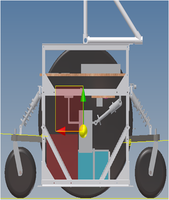By Ben Nitkin on
 This semester, I was invited to work on a Mechanical Engineering Senior Project. (And yes, I need all of those capital letters.) The team is, with the exception of yours truly, entirely composed of MechE's. I was invited when the team leader spoke with Helen, who in turn suggested that I would be useful, what with my background in FIRST Robotics and Linux. (So many capital letters.)
This semester, I was invited to work on a Mechanical Engineering Senior Project. (And yes, I need all of those capital letters.) The team is, with the exception of yours truly, entirely composed of MechE's. I was invited when the team leader spoke with Helen, who in turn suggested that I would be useful, what with my background in FIRST Robotics and Linux. (So many capital letters.)
Each year, the Mechanical Engineering department sponsors a half-dozen senior projects. Each gives a team of engineers some capstone challenge, including SAE Aero Design, Formula Car, and many others. Most of these teams have been around for years; the team one I worked on was brand-new.
IGVC. That's the competition. The competition - the Intelligent Ground Vehicle Competition - challenges teams to design and build robots capable of autonomously navigating a course. Two courses are provided: basic and advanced.
The basic course consists of two lane-lines, about 6' apart that denote a path. The path, roughly rectangular, covers a perimeter similar to a football field. Scattered through the course are various obstacles - garbage cans, construction cones, sawhorses. The robot navigates from its origin to a provided GPS waypoint. One of the lanelines vanishes at the waypoint, and the robot must navigate to the next waypoint without the assistance of lanelines.
In the advanced course, the course is larger, more waypoints are added to the free navigation section and a slalom between colored flags is introduced. The basic rules remain unchanged.
The robot is required to maintain an average speed between 1mph and 10mph through the course. The final score is determined by distance covered, with distance penalties for hitting obstacles and other offences.
Continue to approaches.
I wrote weekly memos for the project adviser. Those are reproduced below for reference.